Japan’s interior design, celebrated for its minimalistic elegance and functional beauty, reflects a profound respect for harmony and mindfulness. Rooted in the country’s rich cultural heritage, this design philosophy seamlessly blends traditional Japanese aesthetics with modern practicality, creating spaces that are both tranquil and adaptable. The use of natural materials like wood not only adds warmth and texture but also embodies the Japanese tradition of “ma”—the thoughtful use of space that fosters a sense of peace and openness.
In contemporary settings, these timeless principles are reinterpreted to align with global design trends, yet they retain their distinctive Japanese style. Japanese minimalist interior design is a testament to this, as it’s exemplified in both a minimalist Tokyo apartment and a suburban home.
The essence of this design philosophy lies in its ability to create a serene, nature-inspired environment. Top tips for achieving this look include incorporating wood to add natural elements, decluttering to maintain a clean aesthetic, and embracing the “less is more” approach to ensure each piece within the space is both purposeful and stylish.
Main Takeaways
- Blend Tradition with Innovation: Japanese interior design seamlessly integrates traditional elements with modern aesthetics, creating spaces that are both timeless and contemporary.
- Embrace Minimalism: Minimalist furniture, neutral color palettes, and clean lines are central to Japanese-inspired interiors, promoting simplicity and harmony.
- Celebrate Cultural Heritage: Incorporate elements like shoji screens, tatami mats, and bonsai trees to pay homage to Japan’s rich cultural heritage and artistic traditions.
- Foster Tranquility: Soft lighting, natural materials, and mindful practices such as meditation or tea ceremonies help create serene and Zen-inspired spaces.
- Partner with Tanic Design: Let Tanic Design bring Japanese design principles to life in your space, crafting bespoke interiors that elevate the guest experience and reflect your brand’s values.
The Essence of Japanese Interior
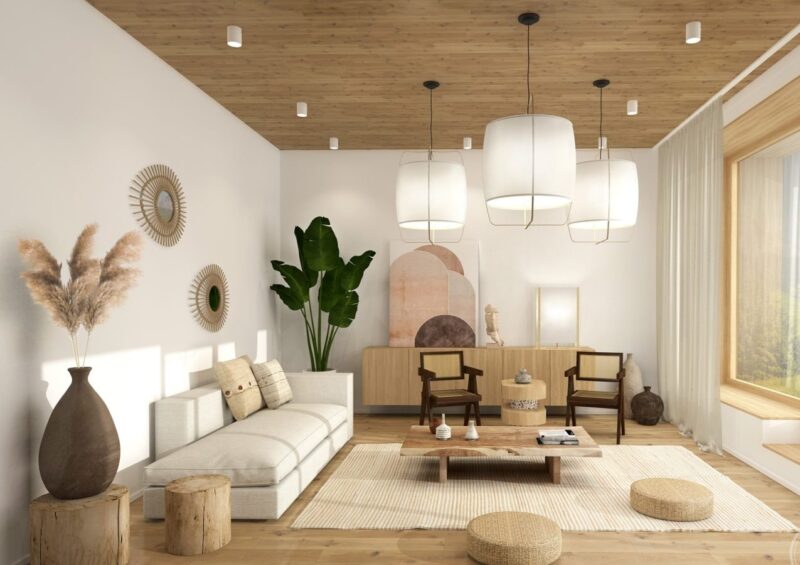
Japanese interior design, with its wabi-sabi ethos and minimalistic charm, offers a serene retreat from the bustling world outside. It’s a style that honors the beauty of natural materials and the imperfections of the world, creating spaces that are both grounded in simplicity and rich in cultural tradition. The Japandi style, a harmonious blend of Japanese and Scandinavian design, further refines this aesthetic, emphasizing clean lines, natural wood, and craftsmanship.
In the heart of a Japanese-styled home, one might find room dividers crafted from oak wood, linen cushions resting on a coffee table, and large windows that frame the greenery of a zen garden—each element thoughtfully chosen to save space and add irregularity.
The interior design, embodying Japanese style design, is a testament to the principles of Japanese interior design, where every item, from a lamp to a stool, serves a purpose beyond its function: to evoke the land of the rising sun and to invite a sense of calm and serenity indoors. This design philosophy is not just about creating a look; it’s about cultivating an experience—a journey to visiting Japan without leaving the comfort of one’s home.
Incorporating Natural Elements
Embracing the Japanese aesthetic, interiors in Japan are a testament to the culture’s deep-rooted connection with nature. Natural elements are not just decorative; they are integral to creating a tranquil and harmonious space that echoes the Japanese culture and traditions. Wood, with its inherent warmth and texture, is a predominant material, often seen in the form of exposed timber beams, shoji screens, and tatami flooring. Stone and bamboo add depth and a touch of rustic elegance, making these materials common in Japanese homes.
Minimalism and Wabi-Sabi: A Design Philosophy
The Japanese interior design style is deeply influenced by the principles of minimalism and wabi-sabi—finding beauty in imperfection. This philosophy is reflected in every aspect of the design, from the decluttering of spaces to the zen garden that brings a piece of nature indoors.
The use of natural materials like wood not only adds to the aesthetic but also serves as functional storage space. Muji, known for its minimalist home goods, exemplifies this design approach, where white creates a backdrop for the natural textures and colors to stand out.
Modern Japanese Style: Integrating Tradition and Innovation
In modern japanese style interior design, there is a seamless blend of traditional elements with contemporary design ideas. Japandi interior design, a fusion of Japanese and Scandinavian styles, incorporates beige and other neutral colors to create bright, open spaces.
Interior designers focus on using natural materials to craft spaces that are both aesthetically pleasing and functional. Commonly found items like a blind or a countertop are designed to enhance the living experience, marrying utility with the timeless elegance of japanese style interiors.
Functional Furniture and Layout
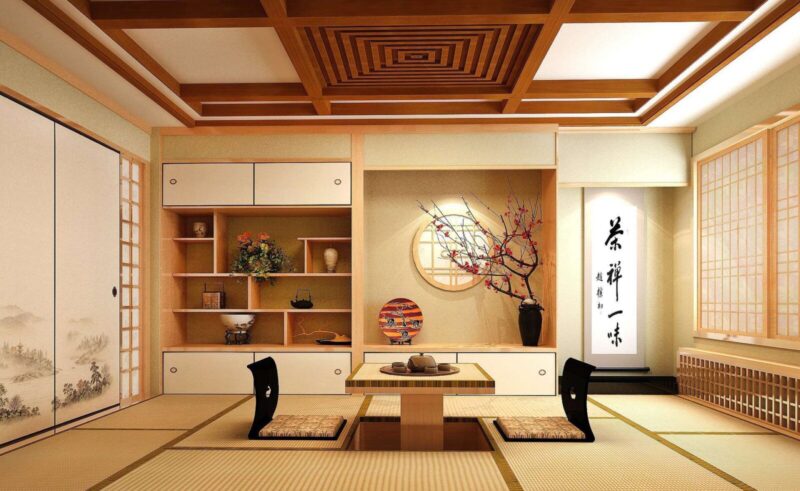
In the realm of Japanese interior design, the fusion of functionality with aesthetic simplicity creates spaces that are not only efficient but also imbued with a tranquil beauty. The interior style is characterized by its ingenious use of multifunctional furniture—think tatami mats that serve as both seating and bedding, or sliding doors that effortlessly redefine living spaces. This adaptability is particularly essential in Japan’s urban interiors, where space is at a premium.
The Japanese concept of ma, referring to the thoughtful use of negative space, is pivotal in crafting an atmosphere of serenity and spaciousness. It’s an approach that allows each element to breathe, from the wooden accents that bring a touch of nature indoors to the minimalist layouts that emphasize the beauty found in simplicity and imperfection, known as wabi. These principles of design create a harmonious environment that is deeply rooted in Japanese traditions and modernism, offering a sanctuary of calm in the bustling rhythm of daily life.
Embracing Zen Aesthetics
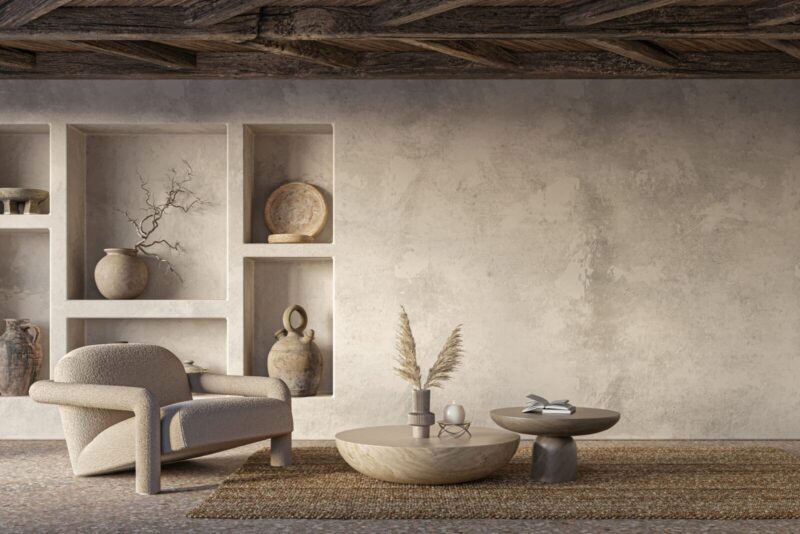
Zen aesthetics, deeply rooted in the principles of mindfulness and simplicity, are a cornerstone of Japanese interior design. This design philosophy, influenced by Zen Buddhism, emphasizes the beauty of imperfection and the importance of living in the present moment. Here’s how Zen aesthetics are integrated into Japanese interiors:
- Simplicity and Mindfulness: The essence of Zen is captured through minimalist decor and sparse furnishings, creating a clean and tranquil environment that encourages a mindful lifestyle.
- Natural Light: Spaces are bathed in soft, diffuse light from paper lanterns and shoji screens, embodying the nature-inspired design and enhancing the connection with the natural world.
- Uncluttered Spaces: Embracing the concept of “ma” (negative space), interiors are kept open and uncluttered, allowing each element to stand out and contribute to the overall sense of calm.
- Organic Materials: Incorporating wood and other natural materials adds warmth and texture, reflecting the japanese house design ethos that values the integration of nature indoors.
- Beauty in Imperfection: Following the principle of wabi-sabi, interiors celebrate the irregularities and unique characteristics of materials and objects, finding harmony in asymmetry and the imperfections of the world.
Modern Interpretations and Innovation
While traditional Japanese interior design principles remain timeless, modern interpretations have evolved to reflect contemporary lifestyles and tastes. Today, designers are blending elements of Japanese design with modern aesthetics, creating spaces that seamlessly integrate tradition with innovation.
Minimalist furniture, sleek lines, and neutral color palettes are combined with technology-driven features and smart home systems to enhance comfort and convenience. Sustainability is also a growing focus, with eco-friendly materials and energy-efficient designs becoming increasingly popular in Japanese-inspired interiors.
Fusion of Tradition and Modernity
In the heart of Japan, a new wave of interior design is emerging, where the timeless principles of Japanese style are being interwoven with modern innovations. This fusion creates interiors that honor the past while embracing the future, featuring minimalist furniture and sleek lines that complement traditional Japanese aesthetics. The result is a living space that is both a nod to Japanese culture and a reflection of contemporary lifestyle.
Smart Homes and Sustainable Living
As technology advances, so does the integration of smart features into Japanese homes. Smart home systems and eco-friendly materials are becoming staples in modern interior design in Japan, reflecting a commitment to sustainability and efficiency. These energy-efficient designs not only enhance the comfort and convenience of the home but also ensure that the spaces we inhabit are in harmony with the environment.
The Beauty of Imperfection
The concept of wabi-sabi, finding beauty in imperfection, is a key element in Japanese house styles. This philosophy is evident in the use of natural materials like wood, which adds warmth and character to the home. The elements are kept simple and uncluttered, allowing the beauty of the materials and the craftsmanship to shine through, creating a tranquil and inviting atmosphere.
Cultural Influences and Artistic Expression
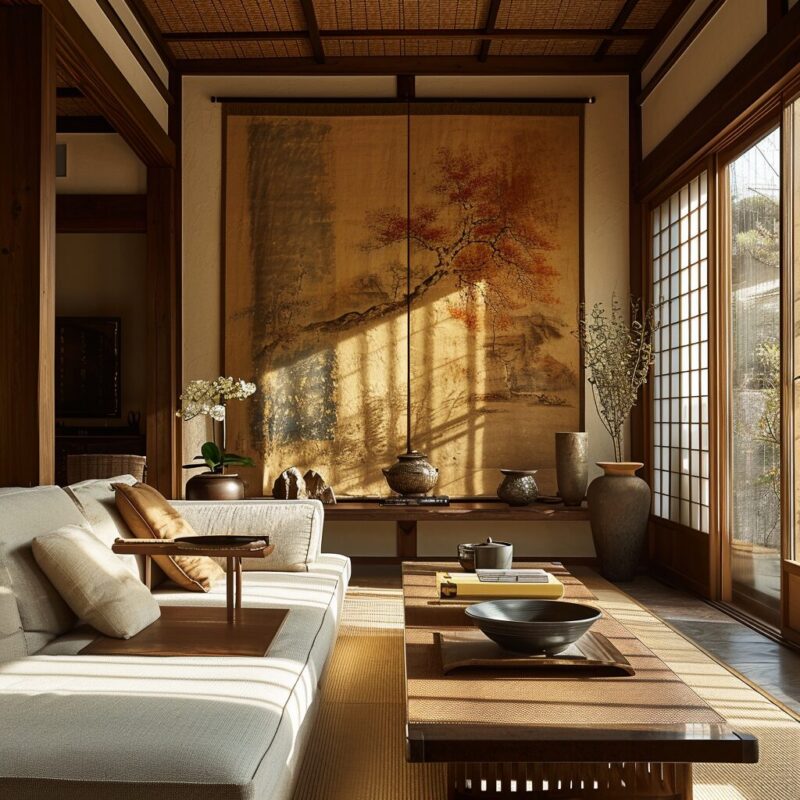
Japanese interior design is deeply rooted in cultural traditions and artistic expressions, drawing inspiration from centuries-old practices such as tea ceremonies, ikebana (flower arranging), and calligraphy. These influences are reflected in the careful selection of decor, from traditional ceramics and textiles to contemporary art pieces that celebrate Japan’s rich cultural heritage. The art of kintsugi, or repairing broken pottery with gold, is a symbolic representation of wabi-sabi philosophy, embracing imperfection and celebrating the beauty of impermanence.
Creating Zen-Inspired Spaces
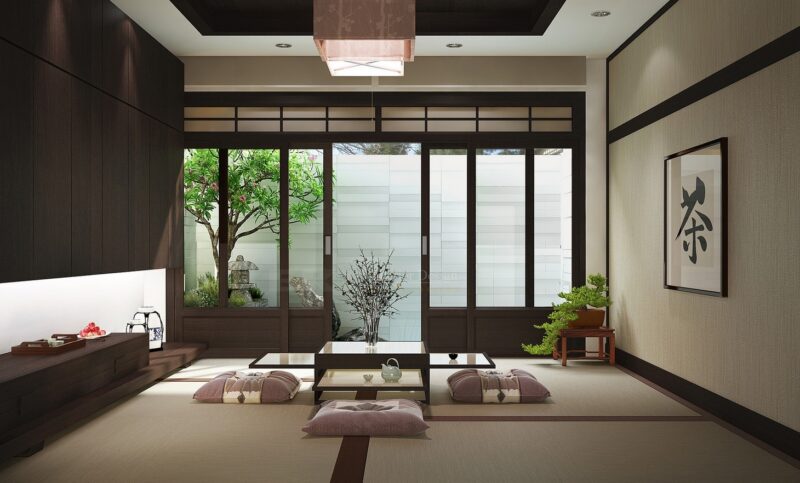
Creating Zen-inspired spaces is an art that combines minimalism, natural materials, and a connection to nature. Here’s how you can refine your interior to embody the tranquil essence of Japanese design:
- Incorporate ‘Shoji’ and ‘Tatami’: Use shoji screens for subtle light diffusion and tatami mats for a traditional Japanese floor covering, enhancing the interior design Japanese style.
- Choose Natural Materials: Select wood, bamboo, and stone to add natural beauty and texture, reflecting the Japanese design home philosophy.
- Embrace Minimalist Decor: Adopt clean lines and neutral colors for a minimalist decor that speaks to Japanese modernism interior design.
- Create Tranquility: Introduce soft lighting, ambient music, and water features to cultivate a serene atmosphere, aligning with Japan’s modern interior design principles.
- Practice Mindfulness: Designate areas for meditation, yoga, or tea ceremonies to encourage a mindful lifestyle within your Japanese-style home.
By integrating these elements, you can transform your living space into a Zen-inspired sanctuary that resonates with the style of design found in traditional Japanese home interiors.
Answering Your Curiosities: Frequently Asked Questions on Japan’s Modern Interior Design
What is Japanese interior design called?
A: Japanese interior design is often referred to as “Nihon no kagu” (日本の家具) or “Nihon no kenchiku” (日本の建築), which translates to Japanese furniture and Japanese architecture, respectively.
What is the characteristic of the Japanese style of interior?
A: Characteristics of Japanese interior design include minimalism, natural materials such as wood and bamboo, neutral color palettes, sliding doors (fusuma and shoji), and a focus on creating harmonious and serene spaces.
Why is Japanese interior design unique?
A: Japanese interior design is unique due to its emphasis on simplicity, functionality, and harmony with nature. It values cleanliness, organization, and a connection to the natural world, which are distinct from Western design aesthetics.
What is the Japanese interior philosophy?
A: The philosophy underlying Japanese interior design is rooted in concepts such as “wabi-sabi” (侘寂), which embraces imperfection and impermanence, and “ma” (間), which refers to the concept of negative space and the importance of emptiness in design.
What is traditional Japanese interior design?
A: Traditional Japanese interior design incorporates elements such as tatami mats, sliding doors (fusuma and shoji), low furniture, rice paper screens, and natural materials like wood and paper.
What is a Japanese-style room called?
A: A traditional Japanese-style room is called a “washitsu” (和室), characterized by tatami flooring, sliding doors, and minimalist furnishings.
What is modern Japanese interior design?
A: Modern Japanese interior design retains elements of tradition while incorporating contemporary aesthetics and functional innovations. It often features clean lines, neutral colors, and a balance between simplicity and sophistication.
What is Japanese architecture style called?
A: Japanese architecture style is often referred to as “Nihon kenchiku” (日本建築) or “Nihon no tatemono” (日本の建物), which translate to Japanese architecture or Japanese buildings.
Conclusion: The Future of Japanese Interior Design Aesthetics
Japanese interior design offers a timeless aesthetic that transcends trends, embracing simplicity, harmony, and mindfulness. By incorporating natural elements, functional furniture, and Zen-inspired aesthetics, you can create spaces that inspire tranquility and elevate the quality of life.
At Tanic Design, we specialize in bringing Japanese design principles to life, crafting bespoke interiors that reflect your brand’s values and enhance the overall guest experience. Let us help you create an oasis of calm and serenity that leaves a lasting impression on your customers.


